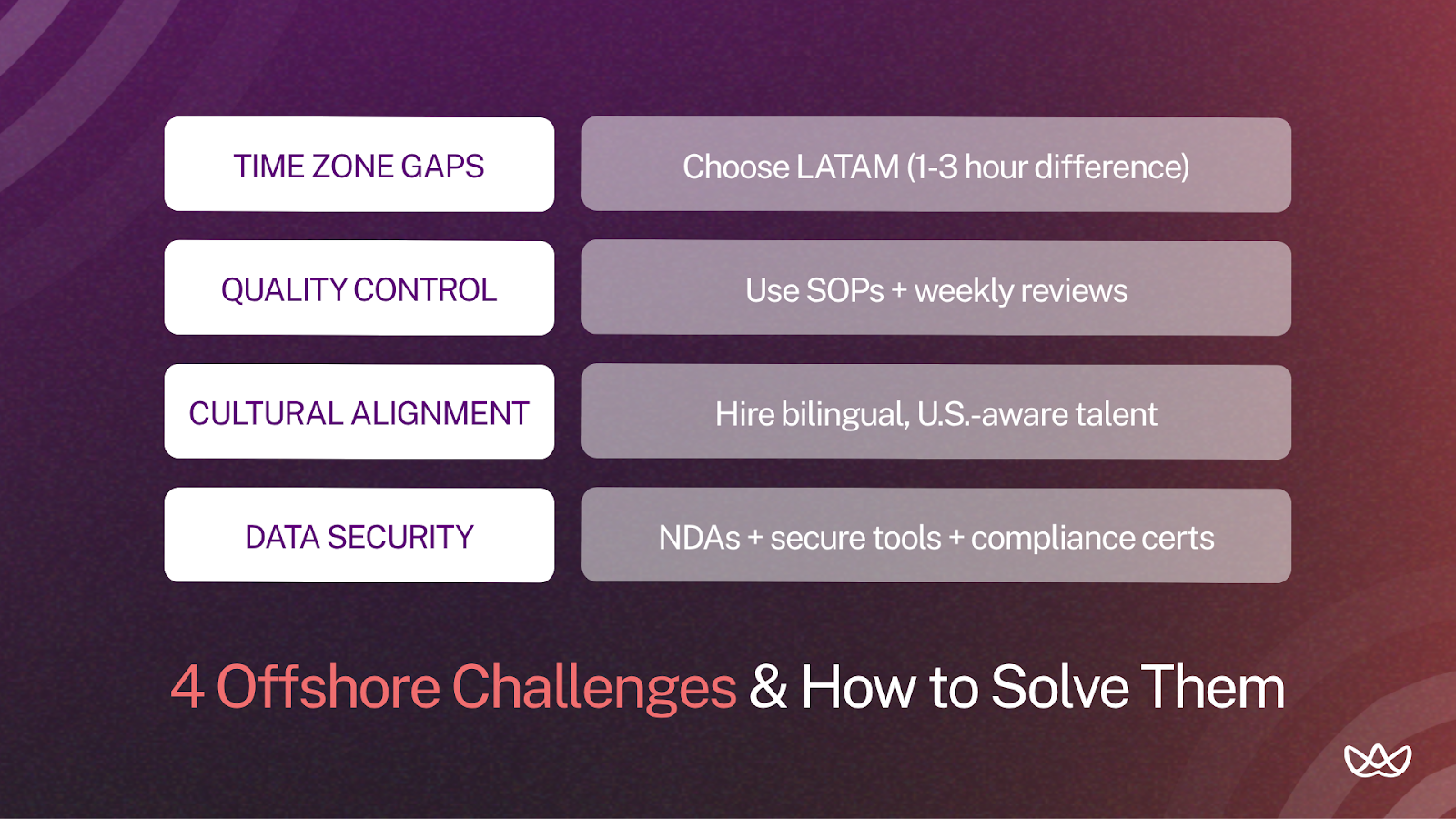Hiring offshore staff has become a normal part of how agencies scale today. Instead of stretching local teams thin or chasing freelancers, many are building steady offshore teams that plug right into their daily operations. It’s a more efficient, reliable way to grow without losing control of quality.
However, Latin America is becoming the top choice for offshore staff solutions. Agencies gain access to bilingual professionals, overlapping time zones, and strong cultural alignment - all key factors that make collaboration smoother and client delivery faster.
Let’s look at the top offshore staff solutions and why LATAM is becoming the preferred choice for agencies.
Hiring Models for Agencies (2025 Overview)
What Are Offshore Staff Solutions (and How Agencies Use Them)
Offshore staff solutions involve hiring full-time professionals based in other countries while your agency retains day-to-day management. This gives you control over projects and deliverables while tapping into talent pools that may not be accessible locally.
This model differs from freelance arrangements. Rather than bringing someone in for a single project, offshore staff become integrated members of your team.
They learn your processes, understand client expectations, and contribute over the long term, allowing your agency to scale consistently without frequent onboarding.
Why Agencies Choose Offshore Teams
Three main reasons agencies go offshore:
- Access to specialized global talent: find professionals with skills that may not be available locally.
- Cost savings: typically 50-70% lower than hiring in-house.
- Faster hiring: fill roles quickly when projects or client needs arise.
Offshore Models Comparison
Offshore staff solutions give agencies the flexibility of freelancers with the consistency of full-time roles. They make it easier to grow teams in a controlled, manageable way.
Key Benefits of Offshore Staff for Marketing and Creative Agencies

1. Cost Efficiency Without Compromising Quality
Offshore hiring can reduce salaries and operational costs by 50-70% while maintaining creative output.
The talent is already available; the difference in cost comes from regional economic factors, not lower quality.
2. Faster Hiring and Team Scalability
Offshore providers can have professionals ready to start in under 15 days. That speed is important when you need to scale campaigns quickly or take on new clients. Traditional local hiring often takes six to eight weeks.
3. Access to Specialized Global Talent
Agencies can tap into niche expertise without long recruitment cycles.
Whether it’s a senior performance marketer with Meta certification or a specialized content strategist, offshore teams make it easier to find the right skill set.
4. 24/7 Productivity and Seamless Operations
Teams in LATAM and Asia can keep campaigns running while your onshore team is offline. They handle monitoring, reporting, and optimization so work continues around the clock.
5. Focus on Core Business Growth
By delegating execution to offshore teams, you focus on strategy, client relationships, and scaling revenue.
Your time goes toward activities that actually grow the business instead of managing every tactical detail.
Why Agencies Are Increasing Offshore Hiring in 2025?
Agencies go offshore to cut costs, access specialized talent, and scale teams efficiently. The key drivers include:
- Cost Efficiency: Labor and overhead can be 50-80% lower than local hiring.
- Specialized Talent: Access skills that may be scarce or expensive locally.
- Remote Work: Distributed teams are easier to manage.
- Flexibility: Scale teams up or down without long-term commitments.
- 24/7 Productivity: Different time zones keep work moving.
- Core Focus: Offshore teams handle routine tasks, freeing in-house staff.
- Risk Management: Providers cover compliance, payroll, and data security.
6 Best Offshore Staff Solutions for Agencies (LATAM & Global Options)
From specialized LATAM firms to global staffing platforms, the following providers stand out for marketing, creative, and tech talent.
1. Floowi - LATAM Talent for Creative and Marketing Teams
Floowi helps U.S. agencies hire vetted full-time professionals in Latin America across marketing, creative, and operational roles. This includes account and project management, client success, virtual assistance, creative and design, digital advertising/social media, and marketing strategy positions.
The focus on bilingual, pre-screened talent allows teams to integrate smoothly. Through Floowi’s nearshore staffing model, agencies access compliant, full-time professionals without handling local payroll or legal requirements.
The platform manages compliance, benefits, and HR while your team retains direct control over day-to-day work, giving the oversight of direct hiring without the administrative complexity of international employment.
2. GrowTal - On-Demand Marketing Experts
GrowTal connects agencies with vetted marketing specialists globally through a fractional staffing model. Candidates are manually screened, and month-to-month contracts make it suitable for SMBs testing offshore staffing.
Pricing is generally lower than U.S. rates but higher than traditional offshore models.
3. CloudTask - Sales and Support Teams at Scale
CloudTask focuses on building LATAM-based teams for sales development, customer support, and B2B lead generation.
They manage recruitment and training, allowing agencies to scale client services efficiently without directly handling operational tasks.
3. Superside - Offshore Design and Creative Staff
Superside offers dedicated creative teams on a subscription basis. Internal creative directors oversee workflow and quality, which makes it useful for agencies with ongoing design or creative production needs.
Monthly costs for basic packages start around $5,000.
4. Workana - Latin American Freelancers for Agencies
Workana functions as an open marketplace for LATAM freelancers. Vetting is minimal since it’s self-rated, so agencies manage quality directly.
It is best for short-term projects or tasks where cost and flexibility are priorities.
5. Remotebase - Pre-Vetted Developers for Fast Scaling
Remotebase specializes in pre-vetted developers, providing quick access to technical talent for agencies scaling development teams.
It supports onboarding and vetting but focuses solely on technical roles, with hourly rates ranging from $40-$70 depending on experience.
Best Offshore Hiring Destinations for Agencies in 2025
Latin America - Bilingual Marketing Professionals with Strong Cultural Fit
LATAM offers English-proficient professionals familiar with U.S. marketing practices and workplace expectations. Time zone overlap allows for easier collaboration during business hours. Countries like Colombia, Argentina, Mexico, and Brazil provide access to marketing and creative talent at lower costs compared to the U.S.
Cultural alignment can make coordination smoother. Professionals in LATAM understand U.S. consumer behavior and media, which helps when handling brand, content, or campaign work.
Eastern Europe - Experienced Tech and Creative Specialists
Eastern Europe has a strong talent pool for technical and design roles. Countries such as Poland, Romania, and Ukraine provide professionals with solid skills in development, data, and design at moderate cost savings compared to U.S. rates.
Time differences of 7-10 hours may require careful planning for real-time collaboration. This region is often better suited for projects with clear specifications rather than tasks needing continuous feedback.
Asia - Cost-Effective Admin and Development Talent
Asia is often chosen for administrative, support, and technical roles due to lower costs. The Philippines, for example, offers English proficiency and familiarity with U.S. business practices.
Time zone gaps of 12-15 hours mean structured processes and clear documentation are necessary to maintain workflow. Agencies generally use this region for support functions, backend development, or operational tasks rather than creative or strategic roles.
How to Build and Manage Offshore Staff for Agency Success
Define Clear Roles and KPIs
Make sure each team member knows what they are responsible for and what they need to deliver. Offshore staff should have the same clarity as onshore employees. Writing down responsibilities, deadlines, and standards helps avoid confusion.
For example, a content writer should understand how much work is expected, the style or tone to follow, how revisions are handled, and what counts as good quality. Clear instructions save time fixing small mistakes later.
Choose the Right Engagement Model
Decide whether you need freelancers or full-time staff. Freelancers are good for specific projects with a fixed timeline. Full-time staff work well if you need steady support and knowledge that builds over time.
Some agencies start with project-based work to test the arrangement and then move the best freelancers to full-time. This approach reduces risk while slowly building a stable team.
Use Project Management Tools
Tools like Slack, ClickUp, or Notion help everyone stay on the same page. They centralize updates, tasks, and progress so you don’t need constant meetings. Offshore staff should use the same systems as your onshore team.
When everyone can see what’s happening, you manage the work instead of checking every small step.
Keep Communication Regular
Set up daily or weekly check-ins depending on the role. Short, frequent meetings help solve small issues before they grow and keep offshore staff connected to the team.
Video calls are better than only messages. Seeing each other makes it easier to understand and reduces mix-ups that happen with text alone.
Offer Training and Feedback
Offshore staff benefit from learning and guidance just like your local team. Giving feedback and opportunities to improve keeps work quality consistent and can reduce turnover.
Provide access to resources and training, and include offshore staff in company-wide learning where possible. This helps them grow with your agency.
Tools for Managing Offshore Teams
A typical setup includes project management (Asana, Monday), communication (Slack, Zoom), documentation (Notion, Confluence), and time tracking (Toggl, Harvest).
The tools are less important than using them consistently and making sure new hires know how to use them.
Common Offshore Staffing Challenges (and How to Overcome Them)

Time Zone Coordination
Pick regions that keep time differences manageable. Nearshore LATAM countries usually have a 1-3 hour difference with the U.S., which allows for several hours of overlap for real-time collaboration. Align this window with your team’s busiest hours for best results.
For work that requires frequent back-and-forth, try to avoid regions more than 5 hours away. Administrative or technical tasks handle bigger gaps better than creative or strategic projects.
Maintaining Quality and Accountability
Clear processes and regular reviews help keep work consistent. Document standard procedures so offshore teams know exactly how to execute tasks. Weekly checks help catch problems before they affect clients.
Feedback should be specific and actionable. For example, say “This headline could better highlight the product benefit” rather than “This isn’t good enough.” Specific guidance helps teams improve without feeling criticized.
Ensuring Cultural Fit
Bilingual staff who understand U.S. business practices work more smoothly on marketing and creative tasks. Fluency matters, but understanding the cultural context is often more important. A technically skilled writer who misses regional references can produce work that feels off to your audience.
During interviews, ask about media habits, brand preferences, and familiarity with U.S. trends. These conversations give insight into whether candidates can create content that resonates with your market.
Data Privacy and Security
Treat offshore staff like onshore employees when it comes to confidentiality. NDAs, secure cloud storage, VPNs, two-factor authentication, and role-based permissions help protect sensitive information.
Some clients require security certifications. Working with offshore partners who maintain standards like SOC 2 or ISO 27001 avoids extra headaches and ensures compliance from day one.
How to Build Long-Term Trust with Offshore Teams
Be open and include your offshore staff in what’s happening at your agency. Share updates, involve them in decisions, and treat them as part of the team rather than outside help. When people feel included, trust comes naturally.
Make a habit of recognizing their work. Mention their contributions in meetings or internal communications.
Even small acknowledgments matter, especially since offshore staff often do work that doesn’t get seen. Recognizing it helps them stay engaged and feel valued.
The Future of Offshore Staffing: Trends Agencies Should Watch in 2025
1. AI-Driven Talent Matching
Predictive algorithms now improve vetting by analyzing work samples, communication patterns, and project success rates. These tools make it easier to find people who fit your team and reduce mismatches compared to relying on resumes alone.
They can also help match work styles and collaboration preferences between managers and offshore staff, which reduces early turnover from misalignment
2. Rise of Nearshore LATAM Teams
More agencies are looking to Latin America instead of Asia because the time zones overlap and communication is easier.
Costs remain lower than domestic hiring, and the region now has better infrastructure, like reliable internet and coworking spaces. This makes working with LATAM teams smoother for everyday collaboration.
3. Flexible Hybrid Models
More agencies mix onshore and offshore staff based on project needs rather than committing to one model. This flexibility lets you optimize for both cost and capabilities. Strategic roles stay onshore while execution work moves offshore.
The hybrid approach also provides business continuity. If onshore staff leave or burn out, offshore team members can step up temporarily until replacements are found.
Your Next Move
With offshore staff in LATAM, you can expand your team without increasing local costs. Give them access to your tools, include them in key meetings, and maintain structured check-ins to keep projects on track and quality consistent.
Start with a small team or a single function, see how they integrate, then scale gradually.
Done right, offshore staff fit naturally into your agency’s operations, helping you deliver more without overloading your onshore team.
Start building your offshore LATAM team with Floowi. Book your free consultation today.
Frequently Asked Questions
What's the average ROI for agencies hiring offshore staff?
Agencies save 50-70% in labor costs while improving output scalability. Most see ROI within the first quarter as they redeploy savings toward growth initiatives or increased margins. A single offshore hire typically saves $30,000-$50,000 annually compared to equivalent U.S. talent.
How do offshore solutions help agencies scale without overhead?
Offshore models eliminate office space, equipment, and benefits costs associated with local hires. You pay for talent, not infrastructure. This lean structure lets agencies grow revenue without proportional expense growth.
What agency roles are best suited for offshore staffing?
Designers, content writers, paid media specialists, developers, customer support teams, and project coordinators work well offshore. Roles requiring deep client relationships or business development typically stay onshore initially, though some agencies successfully offshore account management over time.
Which offshore solution is best for small agencies vs. large agencies?
Small agencies benefit from platforms like Floowi or GrowTal that handle vetting and compliance, removing administrative burden. Large agencies often build internal recruiting for offshore markets or use EOR services for multi-country expansion when team sizes exceed 20-30 people.
How much can agencies save by using offshore staff solutions?
Typical savings range from $30,000-$60,000 annually per role when comparing equivalent U.S. and LATAM talent. Savings increase with team size due to operational efficiencies and reduced per-person overhead.
Should I disclose to clients that I'm using offshore staff?
It depends on your transparency policy. Most agencies focus on deliverable quality rather than team location. Some proactively share their global team structure as a competitive advantage, others don't unless asked. There's no legal requirement to disclose subcontractor locations unless contracts specifically require it.
How do I integrate offshore staff into my agency's project management system?
Treat integration like onboarding any new employee. Provide system access, document workflows, assign a point person for questions, and schedule regular check-ins during the first month. Record training sessions so offshore staff can reference them later.
How quickly can agencies scale offshore teams for new client wins?
Vetted partners like Floowi onboard teams in 10-15 days. This timeline assumes clear role requirements and reasonable expectations around availability. Rush placements can happen in 5-7 days but may limit candidate selection.
How do I ensure offshore work meets client quality standards?
Use defined KPIs, establish QA review processes, and provide continuous feedback. Quality issues rise from unclear expectations more often than talent gaps. Create approval workflows that catch mistakes before client delivery.


.png)







.png)
.png)

